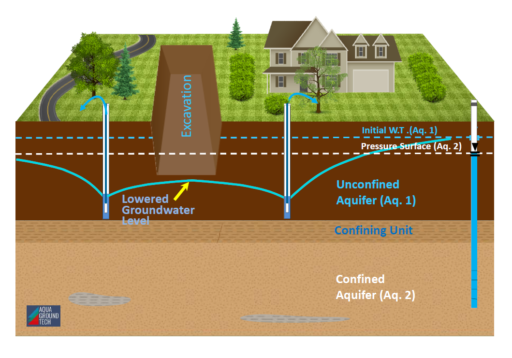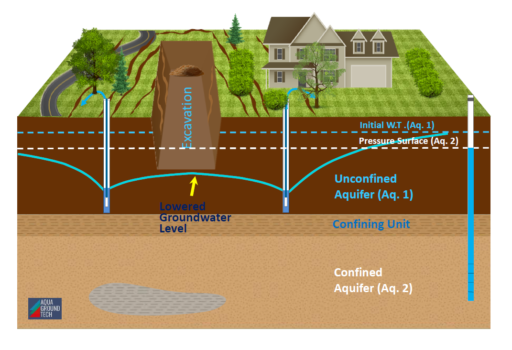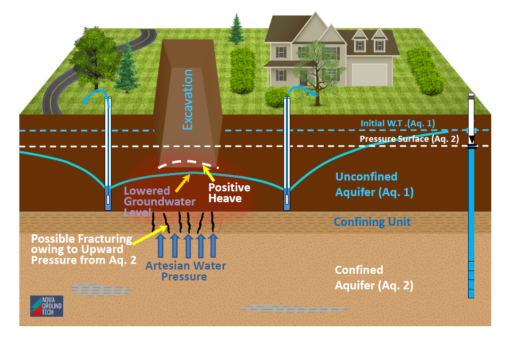Dewatering of shallow subsurface aquifers is essential in engineering support of mining, construction and municipal projects across North America. Dewatering risk is a very important consideration that may be overlooked in a project and can result in expensive and litigious outcomes.
The main site-specific variables that have the potential to pose risk in association with a dewatering project are listed below:
1- Depth of Excavation
2- Groundwater Level versus Final Depth of Excavation
3- Site Lithology
4- Duration of Dewatering/Lowering of Groundwater Level
5- Cost of Equipment / Capital / Time Relating to the Dewatering Project
6- Potential effects on adjacent infrastructure, services and/or buildings/private properties (e.g. owing to possible induced subsidence).
A few examples/scenarios of dewatering and their possible outcomes are illustrated in Figures A through C.
Figure A presents a typical desirable dewatering project with lowering of the water level compared to pre-dewatering water table conditions. LOW RISK
Figure B shows an undesirable outcome as represented by induced land subsidence caused by the use of a risk-tolerant dewatering design. HIGH RISK
Figure C illustrates how the removal of overburden material for excavation purposes also removes the counterbalancing weight that offsets the uplift pressure from the deeper of the two aquifers. HIGH RISK
Double Click the Icon Below to Fill out the Custom Dewatering Toolkit Questionnaire!
The main site-specific variables that have the potential to pose risk in association with a dewatering project are listed below:
1- Depth of Excavation
2- Groundwater Level versus Final Depth of Excavation
3- Site Lithology
4- Duration of Dewatering/Lowering of Groundwater Level
5- Cost of Equipment / Capital / Time Relating to the Dewatering Project
6- Potential effects on adjacent infrastructure, services and/or buildings/private properties (e.g. owing to possible induced subsidence).
A few examples/scenarios of dewatering and their possible outcomes are illustrated in Figures A through C.
Figure A presents a typical desirable dewatering project with lowering of the water level compared to pre-dewatering water table conditions. LOW RISK
Figure B shows an undesirable outcome as represented by induced land subsidence caused by the use of a risk-tolerant dewatering design. HIGH RISK
Figure C illustrates how the removal of overburden material for excavation purposes also removes the counterbalancing weight that offsets the uplift pressure from the deeper of the two aquifers. HIGH RISK
Double Click the Icon Below to Fill out the Custom Dewatering Toolkit Questionnaire!


